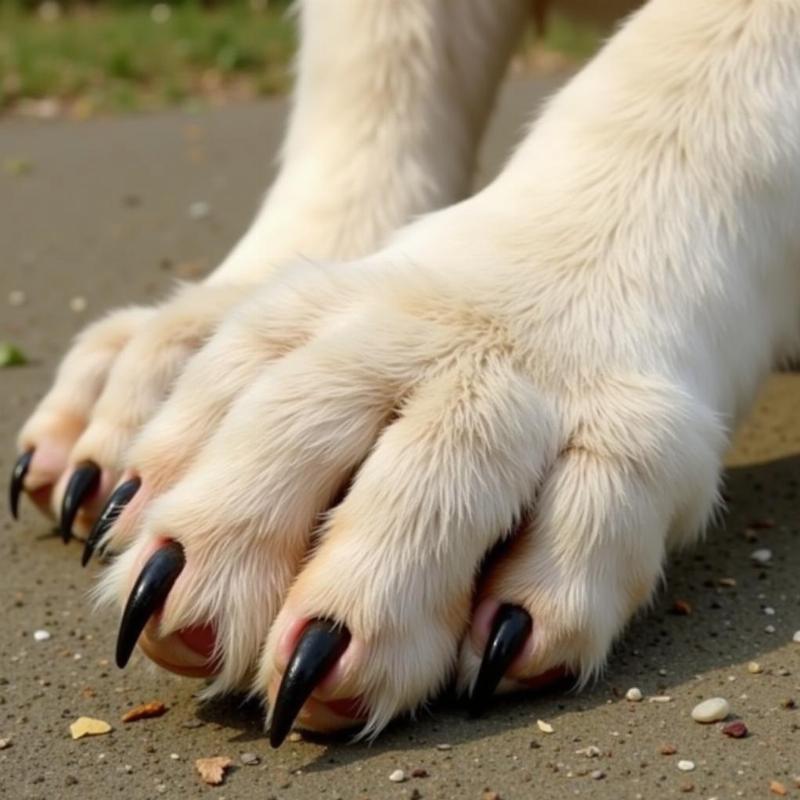Double dew claws, those extra little “thumbs” on a dog’s paws, often pique the curiosity of pet owners. While single dew claws are relatively common, two dew claws on the same paw are more unique and often linked to specific breeds. Understanding the purpose and care of these extra digits is essential for responsible dog ownership. Let’s delve into the fascinating world of dog breeds with double dew claws.
 Dog breeds with two dew claws
Dog breeds with two dew claws
Certain dog breeds are genetically predisposed to having double dew claws, often on their hind legs, a trait sometimes referred to as polydactyly. This is largely due to their history as working dogs, where these extra digits provided enhanced grip and stability in challenging terrains. Breeds like the Great Pyrenees, Briard, Beauceron, and Icelandic Sheepdog often sport double dew claws, a testament to their heritage as herding and guardian dogs. These extra toes aid in navigating snowy slopes, rocky terrain, and even offer better control while turning quickly.
What’s the Purpose of Double Dew Claws?
So, why do some dogs have these extra digits? Double dew claws, particularly on the hind legs, provide enhanced traction and stability. Imagine a dog navigating steep, snowy mountains or herding sheep across uneven terrain. Those extra claws act like cleats, providing a firmer grip. They can also help with balance and agility, especially when making sharp turns.
Breeds Commonly Associated with Double Dew Claws
Several breeds are known for this unique characteristic. The Great Pyrenees, majestic guardians of livestock, are perhaps the most well-known breed with double dew claws. The Briard, with its long, flowing coat, also frequently has double dew claws on its hind legs. Other breeds where you might encounter this trait include the Beauceron, known for its herding prowess, and the Icelandic Sheepdog.
Caring for Double Dew Claws
Just like regular dew claws, double dew claws require regular care to prevent issues. Because they don’t touch the ground as frequently, the nails can grow long and become curved, potentially digging into the paw pad and causing discomfort. Regular trimming is essential. dogs with double dew claws on hind legs
Are Double Dew Claws Problematic?
While generally harmless, double dew claws can occasionally pose problems. As mentioned, the nails require regular trimming to prevent overgrowth. They can also be prone to injury, especially if they get caught on something. In some cases, surgical removal might be recommended if the dew claws are causing recurrent problems. how many bones are in dogs
Expert Insight
Dr. Emily Carter, DVM, a renowned veterinarian specializing in canine orthopedics, notes, “Double dew claws are a fascinating adaptation in certain breeds, offering practical benefits for their historical roles. Regular care is crucial for preventing potential complications.”
Likewise, Dr. Robert Miller, DVM, an expert in canine genetics, adds, “The prevalence of double dew claws in specific breeds underscores the impact of selective breeding on canine morphology and function.”
Conclusion
Double dew claws are a fascinating feature found in certain dog breeds, offering a glimpse into their working history. While often beneficial, they require proper care to prevent potential problems. Understanding this unique characteristic is part of being a responsible owner of these remarkable breeds. By recognizing their purpose and providing proper care, you can help ensure the health and well-being of your double-dew-clawed companion.
FAQ
- Do all Great Pyrenees have double dew claws? While common, not all Great Pyrenees have double dew claws. It is, however, a breed standard according to the American Kennel Club.
- Are double dew claws painful? No, double dew claws themselves are not painful. However, neglecting their care can lead to overgrowth and discomfort.
- Should I have my dog’s double dew claws removed? Removal is typically only necessary if they are causing recurrent issues or injuries. Consult your veterinarian for advice.
- How often should I trim my dog’s double dew claws? Trimming frequency depends on the individual dog and how quickly the nails grow. Generally, every 2-4 weeks is a good starting point.
- Can double dew claws affect a dog’s gait? While unlikely, poorly maintained double dew claws can potentially interfere with a dog’s gait. Regular trimming is essential to prevent this.
- Are there any health concerns associated with double dew claws? Overgrown nails and injuries are the primary concerns.
- Are double dew claws considered a fault in some breeds? In some breeds, the absence of double dew claws might be considered a fault, while in others their presence is irrelevant or undesirable. Consult the breed standard for specifics.
Beautdogs.us is your premier source for all things dog-related in the US. We offer expert advice on dog breeds, care, and products, catering to both novice and experienced dog owners. Our goal is to empower you to provide the best possible care for your furry companion. Learn more about specific breeds, health tips, and product reviews at Beautdogs.us. For personalized guidance and support, reach out to our team via email at [email protected] or call us at +1 501-555-7529.